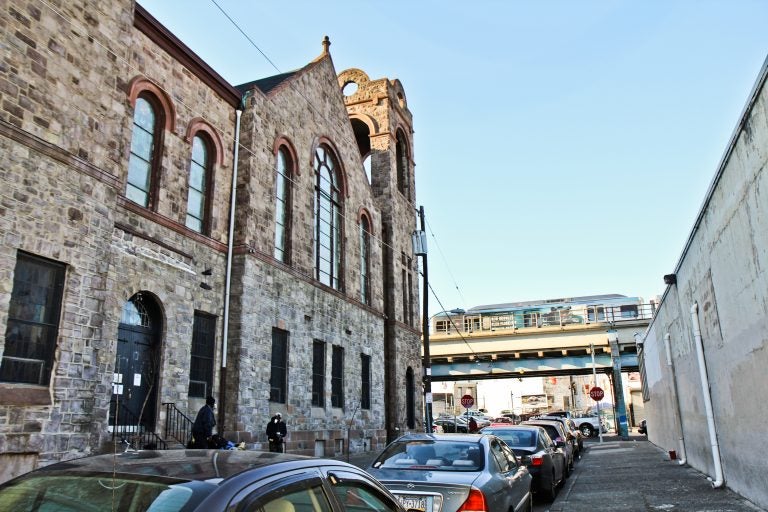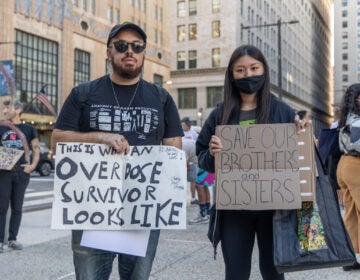Supervised injection at Prevention Point? Ahead of major ruling, Safehouse lacks location and funding
The city’s push to open in Kensington still faces resistance. Meanwhile, the nonprofit has just $200,000 in the bank.

File photo: Prevention Point at the intersection of Kensington Avenue and Monmouth Street. (Kimberly Paynter/WHYY)
Updated 5:12 p.m.
Safehouse, the nonprofit behind Philadelphia’s proposed supervised injection facility, is waiting on a federal judge to determine whether it’s legal to open the first medical site of its kind in the U.S.
The expedited decision, which follows a narrow ruling in Safehouse’s favor last fall, could land as soon as Monday. But the nonprofit needs more than just a legal blessing to open. Specifically, it needs an operating budget and a home — and so far, there have been meager fundraising yields and no resolution in the ongoing debate over location.
On the location front, Mayor Jim Kenney’s administration has been urging Safehouse to open inside Prevention Point, the needle exchange and health clinic on Kensington Avenue, according to two sources with knowledge of the conversations.
Safehouse vice president Ronda Goldfein declined to confirm that plan, while acknowledging Prevention Point has been generally exploring the feasibility of an injection site.
“We’re still in the process of getting all of our paperwork finalized,” she said. “We’re not yet ready to talk about that level of specificity.”
Goldfein did say the nonprofit is readying multiple sites. According to Safehouse board member and former Gov. Ed Rendell, one site under serious consideration is another medical facility in South Philadelphia.
Then there’s the money issue. Safehouse has raised about $200,000 to date, Goldfein confirmed. The annual operating costs for the facility sit in the ballpark of $1 million, though that figure could fluctuate.
Rendell said fundraising has been hindered by the legality question. The nonprofit and its leaders have been stymied by U.S. Attorney William McSwain’s lawsuit seeking to prevent the facility from opening for nearly a year now.
If the court rules in Safehouse’s favor, Rendell is sure the cash will pour in. “If the court grants protection for the site, we have tons of foundations that are ready to go … as much national as local,” Rendell told Billy Penn and WHYY.
Rendell, who ushered in the city’s first needle exchange as mayor in the 1990s, declined to give names of those foundations.
Philadelphia saw over 1,100 overdose deaths in 2018, the highest rate of any large U.S. city. Early estimates from health officials for 2019 suggest a similar death toll, which underlines the sense of urgency.
“The faster we can get up and running, the more lives we can save,” Rendell said. “If we’re going to be the first in the nation, we want this to be done right.”
Prevention Point gamble: Added credibility or ‘a casualty’?
Safehouse’s two-year-long quest to become the first supervised injection site in the U.S. has entangled many stakeholders with divergent viewpoints, pitting the city’s political, law enforcement and civic leaders against one another in a heated battle.
Location has been a sticking point. From the start, advocates pointed to Prevention Point as a natural landing place. Jose Benitez, the facility’s longtime executive director who is also the president of Safehouse, could not be reached for comment.
As it stands, Prevention Point already does everything Safehouse proposes to do — except allow people to inject drugs on its property.
Prevention Point currently offers syringe exchange and the chance for people to be connected to medication-assisted treatment. Its social workers and other employees are equipped with naloxone, and deploy the opioid overdose reversal drug several times a day in response to calls in the surrounding blocks, where public drug use is ubiquitous.
But threats from U.S. Attorney McSwain make the prospect of adding supervised injection risky.
McSwain warned that even with approval from a federal judge, he would use all enforcement mechanisms at his office’s disposal if Safehouse were to open before an appeals process ran its course.
Prevention Point leases its building, a former church under the El on Kensington Avenue, from prominent neighborhood developer George Manosis. He did not return a call for comment.
Scott Burris, director of the Center for Public Health Law Research at Temple University, said that while McSwain technically has the legal authority to arrest people outside Safehouse for possessing drugs, he’s on shakier ground if he storms the building under any legal pretext that would contradict the judge’s previous ruling on the issue.
“Basically, that’s rubbing the judge’s nose in the dirt,” Burris said. “I think it would take huge amounts of chutzpah for the U.S. attorney.”
Burris said co-locating with Prevention Point would raise the stakes and call into question the spirit of McSwain’s effort to shut down Safehouse. On the other hand, it would direct scrutiny toward the longtime facility.
“If at some point things turned against Safehouse, Prevention Point could, in theory, be a casualty,” he said, “which would be even worse for public health in Philadelphia.”
Community opposition won’t stop Safehouse from opening
Safehouse explored the option of leasing a building near the intersection of Kensington and Allegheny avenues last spring.
But after news broke that the nonprofit was nearing a deal, backlash from neighborhood groups sent the nonprofit and the city back to the drawing board.
Now, Philadelphia Managing Director Brian Abernathy says any consensus from Kensington community groups is unlikely — and the city will move forward with or without it. He declined to confirm or deny the administration’s interest in Prevention Point.
“When this was first presented to me, I had significant issues to deal with [too],” Abernathy said. “We are prepared to provide wraparound services to a significant extent. We are also prepared for any public safety concerns.”
Many civic and nonprofit leaders remain opposed to a drug consumption site opening near residential and commercial corridors, arguing it will further entrench Kensington’s status as a haven for dealing and using.
City Councilmember Maria Quiñones-Sánchez, whose district encompasses Kensington, said opening there — specifically in Prevention Point — would do more damage than good to an already-suffering community. She has asked the administration to pilot the site in another neighborhood, to demonstrate it can protect the community.
“The residents should not be asked to tolerate any more,” she said. “This is a slap in their faces and will hurt the political equity Prevention Point has built over the years. The administration has not properly supported the community or PP, and this would be irresponsible.”
Not expensive, but $200k isn’t enough for a year
The annual operating cost for Safehouse will be contingent on several factors, Goldfein said, adding that the nonprofit has drafted several budgets based on different location and staffing models.
Current drug consumption sites operating in Canada and Europe have facilities that are pretty bare-bones, which would also likely be the case in Philly.
“It is not relatively speaking an expensive initiative,” Goldfein said. “This is akin to a clinic where your most expensive element is the staff … to provide sufficient supervision.”
Vancouver opened its first drug consumption site, Insite, in 2003. At about $1.5 million a year, Insite serves about 1,700 unique individuals per month, who perform roughly 220,000 injections per year, according to Health Canada.
Max Tuttleman, a philanthropist with the Tuttleman Foundation, emerged last year as an early Safehouse backer. He confirmed Wednesday that his family’s foundation donated $10,000 to the nonprofit just before the new year.
Tuttleman acknowledged that major donors have concerns about supporting a mission that sits in the crosshairs of federal law enforcement.
“People have those concerns, but I think it’s a great project,” Tuttleman said.
A group of Safehouse supporters, comprised in part of families of those affected by substance use disorder, formed last year to assist with fundraising for a site. Their members did not respond to a request for a fundraising update.
Goldfein noted a surge of small donations received through Safehouse’s website, and said she trusts that more people will open their wallets once they see the site in action.
“We get $5 [and] $3 donations with notes that say, ‘This is all I can do, I’ll try to do more,’” she said.
She added that once open, the facility will “save some lives, offer some treatment, and people will understand that it won’t be the end of the universe.”
WHYY is your source for fact-based, in-depth journalism and information. As a nonprofit organization, we rely on financial support from readers like you. Please give today.






